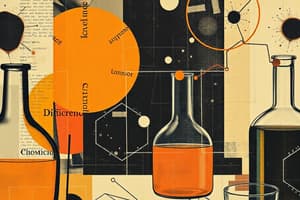Podcast
Questions and Answers
What physical property distinguishes hydrogen chloride from oxygen?
What physical property distinguishes hydrogen chloride from oxygen?
Hydrogen chloride has a pungent odour, while oxygen is odourless.
Identify two metals and their corresponding colours from the provided list.
Identify two metals and their corresponding colours from the provided list.
Aluminium (silvery) and Copper sulphate (blue).
List three colourless gases mentioned in the content.
List three colourless gases mentioned in the content.
Oxygen, hydrogen, and carbon dioxide.
What is the primary characteristic of physical properties according to the content?
What is the primary characteristic of physical properties according to the content?
Which non-metal has a yellow colour and what is its common name?
Which non-metal has a yellow colour and what is its common name?
Describe the colour of nitrogen dioxide and its significance.
Describe the colour of nitrogen dioxide and its significance.
What is the nature of the odour for chlorine and why is it important to note?
What is the nature of the odour for chlorine and why is it important to note?
Differentiate between the colour and odour properties of carbon monoxide and carbon dioxide.
Differentiate between the colour and odour properties of carbon monoxide and carbon dioxide.
What is the main difference between a soluble solid and its liquid constituent when using distillation?
What is the main difference between a soluble solid and its liquid constituent when using distillation?
Define efflorescence in the context of chemistry.
Define efflorescence in the context of chemistry.
What is the principle behind sedimentation and decantation?
What is the principle behind sedimentation and decantation?
Classify sodium chloride and explain why it fits into that category.
Classify sodium chloride and explain why it fits into that category.
Explain the process of desalination and its significance.
Explain the process of desalination and its significance.
What is the key distinction between a homogeneous mixture and a heterogeneous mixture?
What is the key distinction between a homogeneous mixture and a heterogeneous mixture?
Discuss the classification of air within the context of mixtures.
Discuss the classification of air within the context of mixtures.
Why can copper sulphide only be further subdivided by chemical means?
Why can copper sulphide only be further subdivided by chemical means?
What is the main principle behind the process of filtration?
What is the main principle behind the process of filtration?
How does evaporation function to separate a soluble solid from a liquid?
How does evaporation function to separate a soluble solid from a liquid?
In the process of distillation, what happens to the liquid component of a solid-liquid mixture?
In the process of distillation, what happens to the liquid component of a solid-liquid mixture?
Give two everyday applications of filtration and explain their importance.
Give two everyday applications of filtration and explain their importance.
Describe a scenario where evaporation is used in everyday life.
Describe a scenario where evaporation is used in everyday life.
Which gases are classified as tasteless, and why is this significant in various applications?
Which gases are classified as tasteless, and why is this significant in various applications?
What role does temperature play in the processes of evaporation and distillation?
What role does temperature play in the processes of evaporation and distillation?
Why is filtration particularly effective for separating mixtures containing insoluble solids?
Why is filtration particularly effective for separating mixtures containing insoluble solids?
Identify two poisonous gases and one non-poisonous gas, explaining their implications for human health.
Identify two poisonous gases and one non-poisonous gas, explaining their implications for human health.
What gas is considered the lightest, and what implications does this have for buoyancy in practical applications?
What gas is considered the lightest, and what implications does this have for buoyancy in practical applications?
Explain why evaporation might not be suitable for separating a mixture containing volatile solvents.
Explain why evaporation might not be suitable for separating a mixture containing volatile solvents.
Discuss the solubility of carbon dioxide in water and its significance in environmental processes.
Discuss the solubility of carbon dioxide in water and its significance in environmental processes.
Define malleability and ductility, providing examples of metals that demonstrate these properties.
Define malleability and ductility, providing examples of metals that demonstrate these properties.
Explain the concept of efflorescence and give an example of a substance that exhibits this property.
Explain the concept of efflorescence and give an example of a substance that exhibits this property.
What is the boiling point of water, and why is it significant in scientific research?
What is the boiling point of water, and why is it significant in scientific research?
Contrast deliquescence with efflorescence, highlighting their relevance in handling hygroscopic materials.
Contrast deliquescence with efflorescence, highlighting their relevance in handling hygroscopic materials.
What defines a mixture in chemistry?
What defines a mixture in chemistry?
How can mixtures be separated?
How can mixtures be separated?
Give an example of a homogeneous mixture.
Give an example of a homogeneous mixture.
What is the significance of having a fixed composition in compounds?
What is the significance of having a fixed composition in compounds?
How do the properties of mixtures compare to those of compounds?
How do the properties of mixtures compare to those of compounds?
What role does solubility play in the formation of mixtures?
What role does solubility play in the formation of mixtures?
Can mixtures undergo chemical changes?
Can mixtures undergo chemical changes?
Explain the importance of understanding mixtures in daily life.
Explain the importance of understanding mixtures in daily life.
Study Notes
Characteristic Properties of Substances
- Distinctive properties help differentiate substances: colour, odour, taste, nature, density, solubility, melting and boiling points.
Physical Properties of Important Substances
-
Colour in Solids:
- Non-metals: Sulphur (yellow), Coal/Coke (dull black).
- Metals: Zinc (greyish), Aluminium (silvery), Iron (dull), Lead (white), Copper sulphate (blue).
-
Colour in Gases:
- Colourless: Oxygen, hydrogen, carbon monoxide, carbon dioxide, nitrogen, ammonia, sulphur dioxide.
- Coloured: Chlorine (greenish yellow), nitrogen dioxide (reddish brown).
-
Odour of Gases:
- Odourless: Oxygen, hydrogen, carbon monoxide, carbon dioxide, nitrogen.
- Have Odour: Hydrogen chloride, chlorine (pungent), ammonia, sulphur dioxide (choking).
-
Taste of Gases:
- Tasteless: Oxygen, hydrogen, carbon monoxide, nitrogen.
- Have taste: Carbon dioxide, hydrogen chloride, chlorine, sulphur dioxide (slight sour).
-
Nature of Gases:
- Poisonous: Chlorine, sulphur dioxide, ammonia, carbon monoxide.
- Non-poisonous: Oxygen, hydrogen, carbon dioxide, nitrogen, hydrogen chloride.
- Acidic: Hydrogen chloride, chlorine, carbon dioxide, sulphur dioxide.
- Basic: Ammonia.
- Neutral: Oxygen, hydrogen, carbon monoxide, nitrogen.
-
Density of Gases (compared to air):
- Lighter than air: Hydrogen (lightest gas), ammonia.
- Heavier than air: Carbon dioxide, chlorine, sulphur dioxide.
- Almost as heavy: Oxygen, carbon monoxide, nitrogen, hydrogen chloride.
-
Solubility of Gases in Water:
- Highly soluble: Hydrogen chloride, ammonia, sulphur dioxide.
- Fairly soluble: Carbon dioxide, chlorine.
- Slightly soluble: Oxygen, hydrogen, carbon monoxide, nitrogen.
-
Melting and Boiling Points:
- Melting point: Temperature at which solids melt into liquid (e.g., ice at 0°C).
- Boiling point: Temperature at which liquids boil into vapour (e.g., water at 100°C).
-
Malleability and Ductility of Metals:
- Malleability: Ability to be hammered into sheets (e.g., copper, nickel).
- Ductility: Ability to be drawn into wires (e.g., gold, copper).
-
Efflorescence and Deliquescence of Substances:
- Efflorescence: Crystalline substance loses water of crystallization, turning to powder (e.g., washing soda).
- Deliquescence: Water-soluble substances absorb moisture, forming a solution.
Methods of Separation
-
Filtration:
- Used to separate insoluble solids from liquids using filter paper. Solid residue remains on the paper, while the liquid (filtrate) collects below.
- Applications: coffee filters, tea bags, water filters.
-
Evaporation:
- Separates soluble solids from liquids by evaporating the liquid component. Solid remains after evaporation.
- Applications: hot tea cooling, drying wet clothes or hair.
-
Distillation:
- Separates soluble solids from liquids by heating to evaporate the liquid, which is then re-condensed, leaving the solid behind.
- Applications: extracting pure water from saltwater, desalination, liquefaction of gases from air.
Exercises
- Definitions required for efflorescence and deliquescence.
- Differences between elements and compounds, homogeneous and heterogeneous mixtures.
- Principles of sedimentation, decantation, filtration, evaporation, and distillation.
- Classification of substances as elements, compounds, or mixtures.
- Identification of compounds from given substances.
Studying That Suits You
Use AI to generate personalized quizzes and flashcards to suit your learning preferences.
Related Documents
Description
Test your understanding of elements, compounds, and mixtures in Chemistry Chapter 4. This quiz will assess your knowledge of the characteristic properties of various substances. Prepare to distinguish between different substances based on their properties.




